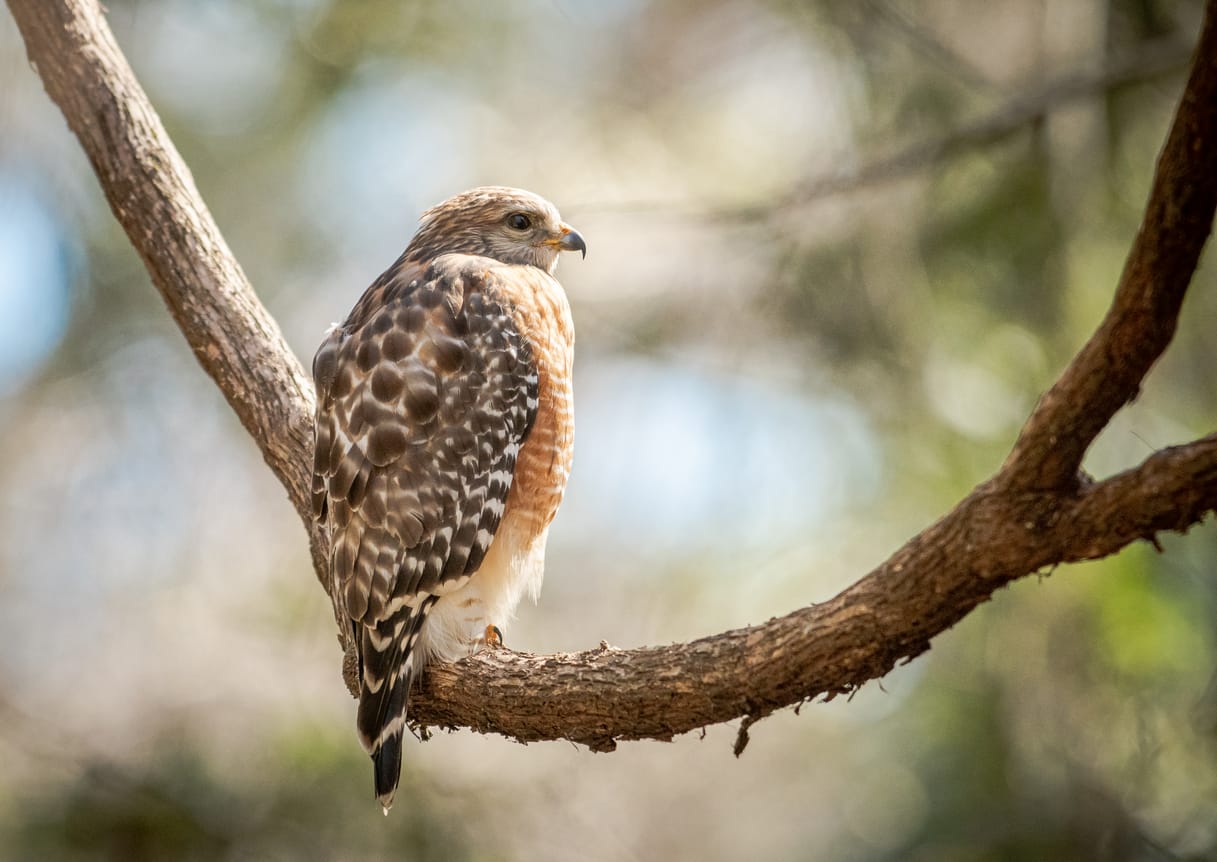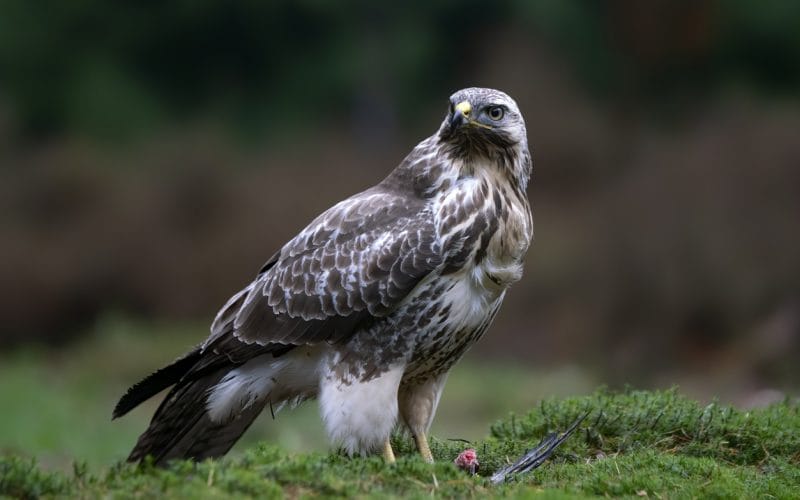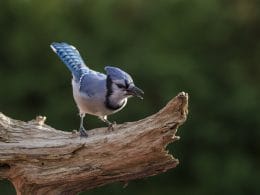Missouri is considered one of the most bird-filled states in North America.
There are approximately 350 species of birds living in or native to Missouri. 10% of these birds are actually rare and threatened with extinction.
Today, we’ll talk in detail about the most common Missouri birds of prey. We’ll go over the most impressive facts about these amazing birds and their unique features, so stick around!
The 8 Most Common Missouri Birds of Prey
1. Cooper’s Hawk

One of the most common Missouri birds of prey is the Cooper’s Hawk. When you’re in the woods or on a suburban lawn with mature trees, you might see the Cooper’s Hawk sitting on a branch inspecting its surroundings.
As this bird of prey sits there, it’s scanning for mice or squirrels.
This full-hearty hawk has a grayish-blue backside, a squarish head, and a long tail that ends in a white band with darker bands above.
The hawk’s outer tail feathers are shorter than its central tail feathers, so the tail looks rounded when slightly open. We can see these shorter outer feathers tucked underneath the long central tail feathers whenever the tail is closed.
Author Note: Cooper’s Hawk has a large body with a big head. Despite being pretty bulky, the male could be as small as half the size of a female.
This relatively bulky hawk has its feathers fluffed to stay warm. The colors of its feathers help it blend with the forest environment.
Cooper’s Hawks have a pale nape, which gives them a capped appearance. To add, their wings are straight.
Juvenile Cooper’s hawks have brown teardrop streaking concentrated on the upper breast. In comparison, the mature Cooper’s Hawk’s breast has orange and horizontal cream streaks and orange or red eyes.
The Cooper Hawk’s lifespan is about 12 years in the wild.
2. Red-Shouldered Hawk

The Red-shouldered Hawk is named after its reddish-brown (rusty) patches on its shoulder. This hawk is found almost everywhere in the U.S. except for Colorado.
Those hawks don’t soar very often and instead perch and hide in trees. Plus, they’re pretty vocal and territorial.
Red-shouldered Hawks have a varied diet, including small mammals, nestling songbirds, frogs, newts, and amphibians. Also, they‘ll wade into ponds to catch aquatic prey such as crayfish.
Author Note: Adult Red-shouldered Hawks have an orange body and a black tail with thin white bands. They also have a dark trailing edge to their wings. Plus, they have unique checkered-colored primers on their wings.
Besides, the upper side of an adult Red-shouldered Hawk has a bold black and white pattern, with red on the head, shoulders, and back. In comparison, juveniles are brown on top.
Notably, both adults and juveniles have thin, translucent crescents near the wingtips that are visible when the sun shines through them. These crescents are one of the best field marks to look for on distant birds when perched.
There are some distinct subspecies of this hawk. The Red-shouldered is the darkest form, and it can be found along the Pacific coast from about the Oregon border down to San Diego.
There’s another form in Florida, the palest. Their heads are almost a light grayish brown, almost like a peach sorbet on the chest.
Finally, the northern form is the largest in Canada, upstate New York, and Maine.
3. Osprey

The Osprey is a giant bird of prey that reaches more than 24 inches in length and has a 71-inch wingspan.
It’s brown on the upperparts and mostly grayish on the bottom parts. Plus, the osprey has arched wings and drooping hands, making it look kind of like a seagull.
Buff fringes may identify the juvenile Osprey based on the upper parts of its plumage, a buff tone on the underparts, and street feathers on the head in flight.
Above all, the outer toe of the Osprey is reversible, which allows it to easily grasp prey with two toes in front and two from behind.
This is really helpful when they grab slippery fish, seeing as fish make up 99% of the Osprey’s diet. This bird of prey sometimes preys on rodents, rabbits, hares, amphibians, and other birds as well—even small reptiles.
These giant birds can be found on every continent except Antarctica. However, they’re limited by available nest sites and their diets.
Because Ospreys almost exclusively eat fish, over time, they’ve evolved to have much longer legs than other birds of prey, enabling them to catch fish with ease.
Actually, Ospreys were once classified with hawks and even had common names like River Hawks, Fish Hawks, and Sea Hawks. Now, they’re classified into their own family with one or two species.
4. Great Horned Owl

The Great Horned Owl is the most common species of owls in North America – and one of the most common Missouri birds of prey. They have adapted to living in pretty much any habitat. It’s because of their diet; they eat pretty much anything they can get their talons on.
The Great Horned Owl gets its name because it appears to have horns on the top of its head, but as you’ve probably guessed, those aren’t horns.
Those horns are actually just tufts of feathers—little feathers on the top of the owl’s head that stick up. It helps them with camouflage.
Great Horned Owls have incredible eyesight. This is a necessary adaptation to help them with their nightlife. Because they’re hunting at night, they need to be able to see what’s going on.
In fact, their eyeballs are much, much larger and more proportional to their skulls than ours. The problem with these giant eyes is that they don’t leave room for much else behind them. So owls don’t have those muscles to turn their eyes around.
Therefore, to look in different directions, they have to move their entire heads around physically. That’s why they have that other infamous adaptation of the ability to swivel their necks.
They can move their necks 270 degrees to the left and 270 degrees to the right, in fact. It helps them look around and identify where their prey is.
5. Snowy Owl

The Snowy Owl is one of the few creatures that symbolize the beauty of Canada’s Arctic. The bright yellow eyes and icy feathers make these owls a striking sight.
Snowy Owls are found in Arctic places worldwide during the summer breeding season. When winter temperatures drop as low as minus 58 degrees Fahrenheit, their thick white plumage camouflages and insulates the snowy owls right down to the tips of their toes.
The Snowy Owls are one of the heaviest owls in North America. They can weigh around 40 to 70 ounces. Besides, their wings reach four to five feet. Usually, these wings help them move silently and sneak up on their prey.
Mature females are larger and have more dark markings than mature males, nearly pure white. The males bring food, whereas the females stay back to take care of the outlets.
Top Tip: Snowy Owls use their beaks to sense objects. Their beaks are extremely sensitive and covered with facial feathers. Plus, they don’t chew their food. Instead, they swallow it whole.
Most owls hunt at night, whereas snowy owls hunt during daylight. Plus, they’ve got a great sense of sound and sight.
Snowy Owls migrate long distances. They’re migratory birds that travel back and forth from one tip of the world to another.
While some owls remain there year-round, others will fly south during the winter months where they will often be seen in open, treeless areas like farm fields and marshes.
6. American Barn Owl

Barn Owls are also called heart-shaped-faced owls. They’re found on every continent except Antarctica. Also, they can live for up to 25 years.
Barn Owls are among the fastest birds. They can fly almost silently. This allows them to hear even the tiniest sound generated by rats beneath them.
Those owls have pretty long legs, toes, and talons, which allow them to catch prey hidden deep within vegetation. Their diet consists mainly of small rodents such as mice, voles, fat rats, and moles.
On average, a wild barn owl eats around four small mammals per night. That’s approximately 1,500 per year.
Barn owls hunt at night. Although they have perfect eyesight, they rely primarily on their sense of hearing.
Those owls can identify the movement of the tiniest prey in complete darkness, according to researchers, because of their exceptional hearing.
The left ear captures sounds below during the flight, while the right ear focuses on sounds from above.
The heart-shaped-faced owls don’t hoot; they screech. Plus, they’ve got a wingspan of up to 47 inches.
The owls’ bones are flexible, as it allows their heads to turn up to 270 degrees. Also, they’re equipped with three eyelids per eye: one is for blinking, one closes when sleeping, and the other cleans and protects the eye.
In fact, females lay four to eight eggs each day on average, with up to 15 eggs being laid in exceptional cases. It takes 25 to 35 days for the eggs to hatch.
7. Bald Eagle

Bald Eagles are considered sea eagles. Their common name is derived from “piebald,” which means two colors, usually black and white. So it doesn’t literally mean an eagle without head feathers, but rather an eagle with contrasting colors.
Adult Bald Eagles have stark white heads and tails against dark brown body feathers. Their eyes, beaks, and legs are yellow.
In comparison, juvenile Bald Eagles don’t have these unique markings and can easily be confused with similar-looking golden eagles.
Female Bald Eagles are physically larger than males. A few speculations are that females take charge of nesting duties, and being larger may help them be more dominant in doing so.
It could also be just the simple fact that the mother eagle will stay and protect her baby eagles, and needs a more intimidating presence.
Moreover, Bald Eagles have a wider field of view and sharper vision than humans. They can also see ultraviolet light.
They have two eyelids: one normal pair of eyelids like humans have and another called a nictitating membrane, a see-through eyelid that keeps the eyes moist, which is needed when flying around all day.
A Bald Eagle can catch their food with no problem, but why go to all that work when it’s easier to steal food?
Bald Eagles are known for chasing down other birds that have caught fish and continually chasing them until they give up their catch to the eagle.
They’re also known for eating all sorts of garbage out of dumpsters.
8. Turkey Vulture

Turkey Vultures are huge blackbirds with broad wings and long tails. They’re bigger than most raptors, except when it comes to eagles and their relatives’ condors.
Actually, they’re one of the most commonly seen birds in northeastern Ohio, and as a species, they range from southern Canada to the southern tip of South America.
Top Tip: When in flight, Turkey Vultures are seen to have long feathers that look like fingers and a long tail that extends past the tips of their toes. They also hold their wings slightly raised when flying, making a V shape.
Turkey Vultures are dark brown with a featherless redhead and a light beak. They derive their name from this featherless redhead, which resembles a turkey.
They don’t have feathers on their heads to stay clean while eating. In other words, carrion, or dead animal meat, doesn’t stick to the skin as well as feathers.
Besides, this black vulture has white fingertips, so seeing a large number of white feathers on the bottom is essential to detect the Turkey Vulture from the black vulture in flight.
In addition, Turkey Vultures have been known to smell carrion from over a mile away. This means that the turkey vulture has the strongest smelling system of all birds.
Final Words
Birds of prey usually catch everyone’s eye. They’re always distinguished by sharp, exceptional characteristics that make them more unique from the rest of the birds.
So, hopefully, our article provides you with catchy and helpful information regarding the most common Missouri birds of prey.
FAQ
Only slightly larger than the American Robin, the American Kestrel is the smallest bird of prey in Missouri.
The Swallow-tailed and Mississippi Kites are regularly seen in Missouri. An occasional White-tailed Kite has also been reported through eBird.
Yes, there are in fact Golden and Bald Eagles seen in Missouri.










